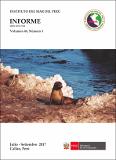Por favor, use este identificador para citar o enlazar este ítem:
https://hdl.handle.net/20.500.12958/3218| Título : | Biovolúmenes de zooplancton e ictioplancton en otoño 2014 |
| Otros títulos : | Biovolumes of zooplankton and ichthyoplankton in autumn 2014 |
| Autor : | Correa Acosta, Jonathan Aronés Flores, Katia |
| Palabras clave : | Zooplancton;Ictioplancton;Engraulis ringens;Vinciguerria lucetia;ondas Kelvin;Anchoveta |
| Fecha de publicación : | 2017 |
| Editorial : | Instituto del Mar del Perú |
| Citación : | Inf Inst Mar Perú 44(3), 2017, p. 332-343 |
| Citación : | Informe IMARPE;44(3), 2017 |
| Resumen : | Durante el otoño del 2014, entre 03°30’S y 10°S se colectaron 94 muestras de zooplancton
usando una red Hensen (300 μm) mediante arrastres verticales de 50 m de profundidad a la superficie.
Los biovolúmenes fluctuaron entre 0,5 y 50,0 mL/muestra, con una media de 10,9 mL/muestra. Los
biovolúmenes entre 5,1 y 10,0 mL/muestra fueron más frecuentes (40,4%) a diferencia de los biovolúmenes
mayores de 20 mL/muestra (7,4%). El grupo que más aportó fueron eufáusidos (principalmente adultos).
Se determinaron 51 familias y 27 especies del ictioplancton. Phosichthyidae fue la familia más abundante
(34,6%) y frecuente (49,5%) representada por Vinciguerria lucetia (Garman, 1899); los huevos de esta especie
se distribuyeron alejados de la costa, fueron abundantes frente a Pimentel; las larvas se presentaron en toda
el área localizando sus mayores abundancias frente a Casma, Malabrigo, Punta La Negra y Punta Sal. Otras
familias frecuentes fueron: Myctophidae (30,1%) y Engraulidae (27,9%); los huevos de anchoveta Engraulis
ringens Jenyns, 1842 solo se distribuyeron sobre la plataforma entre Malabrigo y norte de Chimbote,
mientras que las larvas con similar distribución, fueron más abundantes frente a Punta La Negra. Las
larvas de Anchoa nasus (Kner y Steindachner, 1867) se distribuyeron entre el norte de Punta Sal y Punta
La Negra, su abundancia fue 210 larvas/m2. Cabe destacar la presencia de larvas de peces comerciales del
orden Pleuronectiformes y de las familias Sciaenidae, Gobiidae, Mugilidae, entre otras. La variabilidad del
ictioplancton respondió a la dinámica de las aguas de mezcla entre masas de ACF, ASS, ATS, sumado al
efecto superficial de calentamiento por ondas Kelvin que acontecieron en dicho periodo. ABSTRACT: During autumn 2014, between 03°30’S and 10°S, 94 zooplankton samples were collected using a Hensen net (300 μm) by vertical trawls 50 m deep to the surface. Biovolumes fluctuated between 0.5 and 50.0 mL/sample, with a mean of 10.9 mL/sample. Biovolumes between 5.1 and 10.0 mL/sample were more frequent (40.4%) than biovolumes larger than 20 mL/sample (7.4%). The group that contributed most were euphausiids (mainly adults). 51 families and 27 species of ichthyoplankton were determined. Phosichthyidae was the most abundant family (34.6%) and frequent (49.5%) represented by Vinciguerria lucetia (Garman, 1899); the eggs of this species were distributed away from the coast, were abundant in front of Pimentel; the larvae were present in the whole area, finding their greatest abundance in front of Casma, Malabrigo, Punta La Negra and Punta Sal. Other frequent families were Myctophidae (30.1%) and Engraulidae (27.9%). The anchovy eggs Engraulis ringens Jenyns, 1842 were only distributed on the platform between Malabrigo and the north of Chimbote, while the larvae with similar distribution, were more abundant in front of Punta La Negra. The larvae of Anchoa nasus (Kner and Steindachner, 1867) were distributed between the north of Punta Sal and Punta Negra, its abundance was 210 larvae/m2. It is possible to emphasize the presence the larvae of commercial fish of the order Pleuronectiformes and of the families Sciaenidae, Gobiidae, Mugilidae, among others. The variability of the ichthyoplankton response to the dynamics of the mixing waters between the masses of ACF, ASS, ATS, added to the surface effect of Kelvin wave heating occurred during that period |
| URI : | https://hdl.handle.net/20.500.12958/3218 |
| ISSN : | 03787702 |
| Aparece en las colecciones: | Informe vol. 44(3) 2017 |
Ficheros en este ítem:
| Fichero | Descripción | Tamaño | Formato | |
|---|---|---|---|---|
| Informe 44(3)2.pdf | 4,28 MB | Adobe PDF |  Visualizar/Abrir |
Este ítem está sujeto a una licencia Creative Commons Licencia Creative Commons

